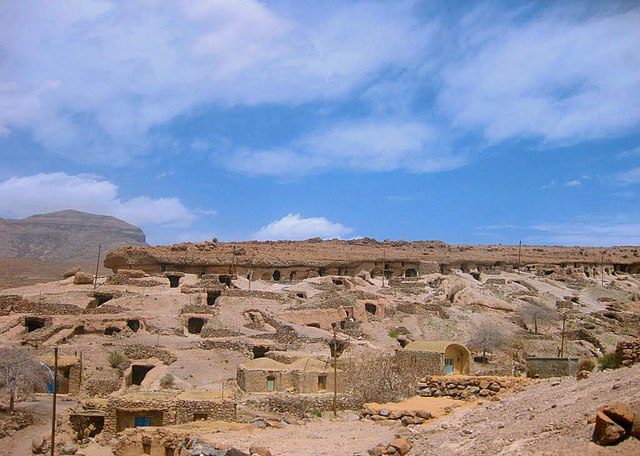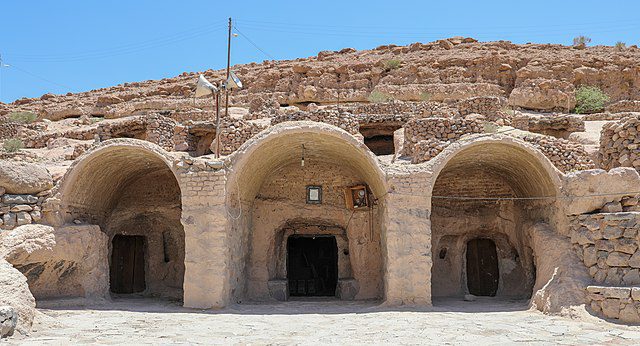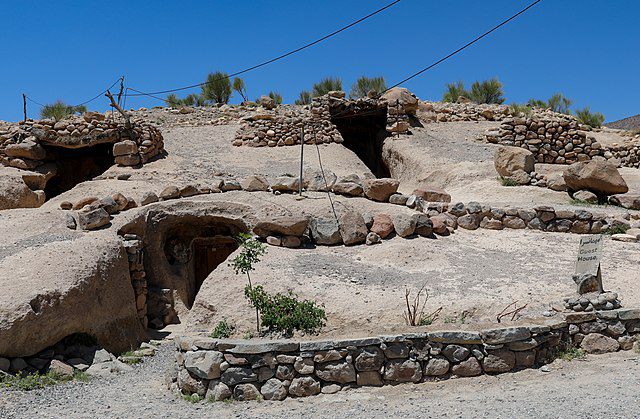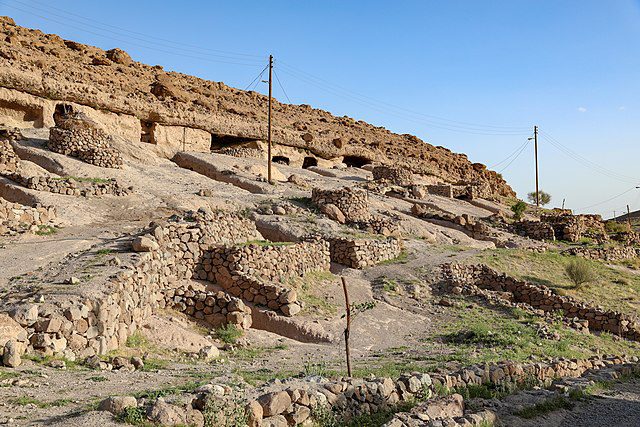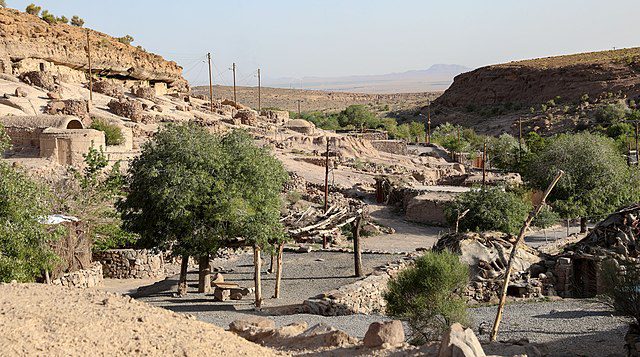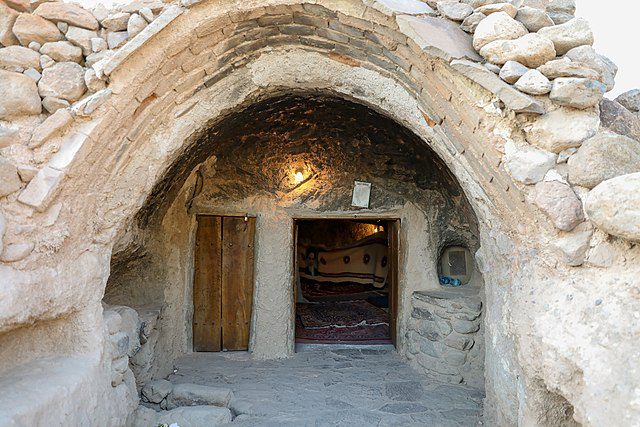Table of Contents
In Iran’s Kerman Province, Meymand village, an Iranian UNESCO World Heritage Site, offers a glimpse into an ancient way of life. While caves may seem like relics of the past, the village stands as a remarkable blend of human craftsmanship and nature’s beauty.
The village’s charm lies in its harmonious connection with the environment. Carved stone houses, shaped by generations of inhabitants, showcase human resilience in the face of challenging terrain. This living testament to history invites curious souls to step back in time, where the past and nature coexist in captivating unity.
Location of Meymand, Kerman
In the heart of Kerman Province, Iran, you’ll discover the historic village of Meymand Iran. It’s just 36 kilometers northeast of Shahr-e Babak city, with the Khatun Abad plain to the south and the impressive Mount Khorin to the northwest.
The village is strategically placed, connecting it to key cities like Yazd, Kerman, and Shiraz. It shares its northern border with Rafsanjan and brushes against the lively city of Sirjan in the southeast. This special location makes this village a must-visit destination for those seeking history and natural beauty.
Meymand History
The village, which has been inscribed in the list of UNESCO World Heritage in 2015, is one of the most exceptional living complexes that has been formed according to the needs of human beings and environmental conditions.
This prehistoric cave village is in the central district of Shahr-e Babak County in Kerman Province, Iran. This village is one of the few ones whose rocky architecture is widely used in the whole structure of the village.
Meymand Rocky Village
One of the main differences between this village from other similar cases is that people are living and life is still going on in there. In this ancient village, people are living in rocky and handmade houses with a history going back to 12000 years ago.
In other words, the village is an outstanding achievement of the genius of human art in the distant past, in such a way that with minimum facilities they made an amazing heritage. This village after many years has remained relatively intact and has a high resistance to heat and cold which is a result of being dug underground.
Meymand Architecture: A Village Landscape
As mentioned above briefly, the village’s architecture and structure is what makes it unique and remarkable. Its houses weren’t built by laying stones and bricks together. It’s been shaped by the removal of a bunch of soil to make a shelter. That’s why there are many niches by removing masses of soil to make room for places to put blankets, pillows, dishes, boxes, and lights.
Generally, These houses include one or more rooms and stables which make a ‘Kicheh’ in the Meymand dialect. It means an alley. There are 400 Kicheh’s in this village. This unit has a shared entrance and in the staircase, there might be a stable on one side and a living room on the other side.
Also, Rooms in Kicheh aren’t geometrically regular. For example, there is a 3*4 room with 1.90 to 2.10-meter height in most Kichehs, the biggest Kicheh doesn’t exceed 90 square meters. Experts believe that smoke from cooking and burning firewood for heating results in isolation and prevents them from destruction.
Settlements in Meymand
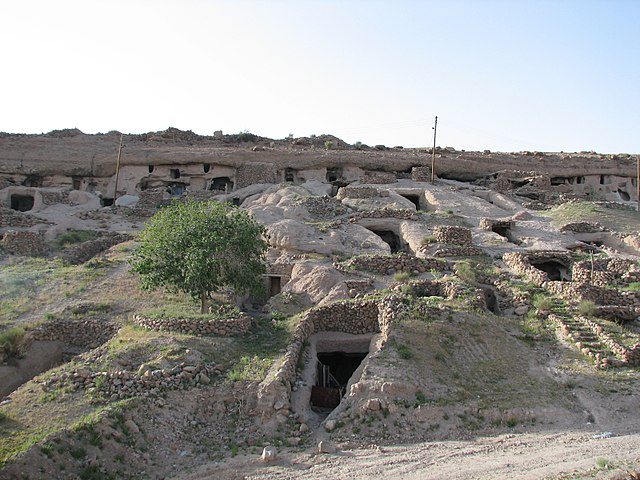
In Meymand Kerman, there are three special types of homes that change with the seasons. First, during spring, people live in Saraghols. These strong structures keep them safe from unpredictable weather and wind. There are two kinds of houses here: Maarkhanen, which are partly underground and round, and Mashkdan houses, which stand above the ground with stone walls and cone-shaped roofs.
In the summer, folks move to Sarbagh houses, which are found near the seasonal rivers. These homes are built using lightweight materials like leaves and branches to beat the summer heat.
When winter arrives, the Village becomes the place to be. People live in hand-dug units called Kicheh, keeping warm together. There are 400 Kicheh units in Meymand, with over 2500 rooms. Each Kicheh connects to another and in the past, the walls were blackened by room fires. Nowadays, some families have turned their storerooms into kitchens to avoid the soot.
The Fire Temple: A Window into the Past
Long ago, Meymand was home to Zoroastrians and pre-Zoroastrians. Evidence suggests that a building called “Kicheh Dobandi,” or “two bands room,” served as a fire temple (Atash-kadeh). This unique structure had two fireboxes, hinting at its role as a fire temple. Today, it has become the Museum of Anthropology, where you can learn about the village’s ancient customs and beliefs.
The Old Public Bath: A Place of Togetherness
In the past, Meymand’s people valued their public baths. It had hot and cold pools, providing comfort and hygiene. In winter and autumn, villagers used it for warmth, while in other seasons, open-air baths were preferred. The public bath’s design resembles those from the Safavid era, highlighting its historical importance as a communal space.
Mosque: A Spiritual Center
At the heart of Meymand UNESCO World Heritage Site stands the village mosque, covering 120 square meters. It’s adorned with handmade carpets, creating a tranquil atmosphere. Built two centuries ago, the mosque remains a place for worship, gatherings, and reflection. It’s a symbol of the village’s enduring religious traditions and community spirit.
How to Get to Meymand
To reach Meymand, Kerman, you’ve got three ways to go:
Train Trip
If you enjoy train rides, catch one between Tehran and Bandar Abbas. Get off at Khatoun-Abad station, which is about 50 kilometers from Shahr-e-Babak. From there, you’re not far from the adventure that awaits in this village.
Car Journey
If you have your own car, it’s a 36-kilometer drive northeast from Shahr-e-Babak to Meymand. Once you arrive, there’s a parking area set up for visitors. It’s a road trip with lots of possibilities.
Plane Ride
For a faster route, book a flight to Sirjan, the closest airport to Meymand. You can also consider Kerman flights as another way to get here. No matter how you choose to travel, the village is ready for you to explore.
Where to Eat near Meymand
When you’re ready to try some local grub, Meymand and the nearby areas have a variety of tasty options:
Dast-Kand-Sangi Restaurant
For an authentic taste of local food, check out the Dast-Kand-Sangi restaurant right in Meymand. It’s in one of the old houses in the village, and they serve up traditional dishes that’ll give you a real sense of the place.
Noon-o-Namak Traditional Restaurant
If you head to Shahr-e-Babak for a meal, give Noon-o-Namak Traditional Restaurant a try. They dish up local favorites, so you can get a true taste of the area.
Iranowich Fast Food
If you’re in a hurry and craving fast food, stop by Iranowich Fast Food in Shahr-e-Babak. They’ve got quick and tasty options for a convenient meal.
Whether you want to savor the local flavors or grab a quick bite in Shahr-e-Babak, you’re in for some delicious treats that will leave your taste buds happy.
Where to Stay near Meymand
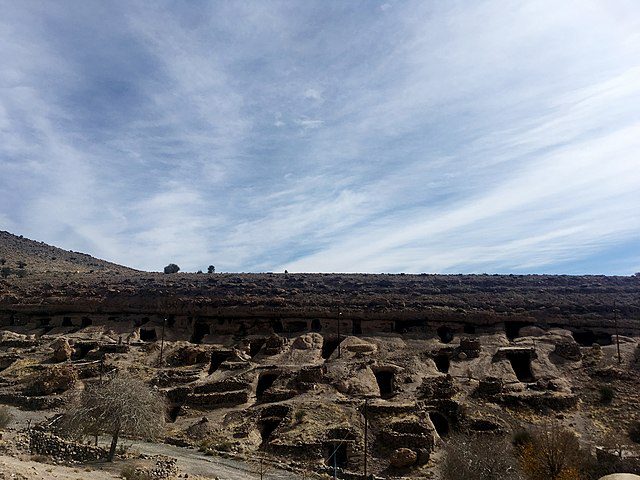
When it’s time to find a place to sleep, the village and the nearby areas offer different choices for all kinds of travelers:
Meymand Guesthouse
For an authentic experience, you can stay at the traditional Guesthouse right in the village. Here, you can sleep in a handmade cave for a truly memorable night.
Shahr-e-Babak Stays
If you’d rather stay in Shahr-e-Babak, you can pick the eco-friendly Rivas eco-lodge or Duna eco-lodge. They’re peaceful places to relax close to nature.
Luxury in Kerman
If you want a bit of luxury, Kerman has some great options. Consider booking a room at the Pars Hotel or Kerman Jahangardi Hotel. They’re known for their fancy amenities and great service.
Affordable Choices in Kerman
Traveling on a budget? No problem! Kerman also has affordable options. Govashir Hotel and Akhavan Hotel offer comfy stays that won’t empty your wallet.
No matter where you stay, your trip to this village promises to be a memorable adventure, whether you’re sleeping in ancient caves or enjoying the comforts of nearby cities.
FAQs about Meymand
Q1: Where is Meymand village located in Iran?
A1: The village is located in the Kerman Province of Iran, approximately 36 kilometers northeast of Shahr-e Babak city.
Q2: What is the history of Meymand village?
A2: The village has a history dating back 12,000 years, with people still living in rocky and handmade houses. It is a testament to human resilience and architectural ingenuity.
Q3: What is the significance of Meymand village in Iran?
A3: The village is a UNESCO World Heritage Site known for its ancient rock-carved houses and its unique blend of human craftsmanship and natural beauty.
Q4: What are the notable attractions in Meymand village?
A4: The village features attractions like the Fire Temple, an old public bath, and a mosque that offer insights into its history, religious traditions, and community life.
Q5: How can I travel to Meymand village, Kerman?
A5: You can reach the village by train (to Khatoun-Abad station), car (a 36-kilometer drive from Shahr-e Babak), or plane (to Sirjan or Kerman airports), depending on your preference and convenience.
Experience the Best of Meymand in Kerman with Customized Tours
When planning a journey to Iran, particularly to explore the mesmerizing beauty of Meymand in Kerman, it’s essential to consider a travel experience that aligns perfectly with your preferences and interests.
At To Iran Tour, we understand that every traveler is unique, with distinct interests, schedules, and expectations. Our mission is to provide you with an unforgettable travel experience in Iran by tailoring your journey to match your preferences.
Contact us today, and together, we’ll design the perfect Customized Iran Tour that suits your preferences and ensures an enriching travel adventure in this extraordinary land.

